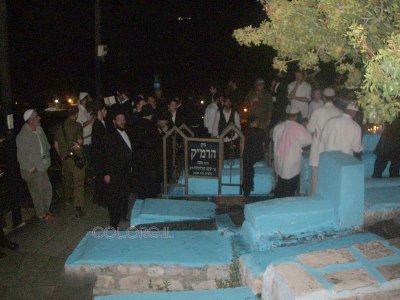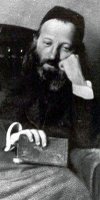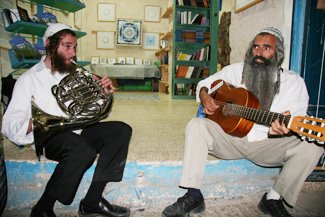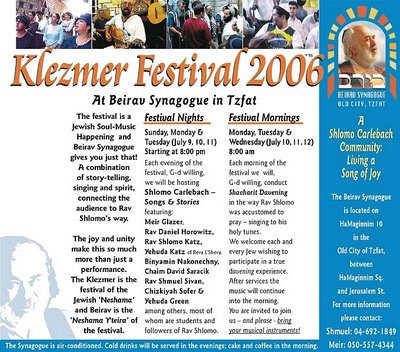Monday, July 31, 2006
Simcha Ma Zeh Oseh – What Does Joy Do?

***
this next part is part of an appreciation I wrote after the Rebbe ZT”L was niftar, six years ago:
In the early 1980's, a Rav whom I was close to showed a group of us a new sefer that had just been published. It was called Nesivos Shalom, by the Slonimer Rebbe. The Rav himself is quite a talented teacher and has a large following himself, but he told us how he was in awe of this sefer - that it spoke to him in the deepest way. He was kind enough to begin learning it with a group, every Shabbat morning before the Shacharit Tefilla. We were quite impressed at the Rebbe's eloquent style, and the depth of the matters that he touched on. We eagerly attended these shiurim, and reviewed the lessons on our own as well. As we progressed through the sefer, we were amazed to know that its author was a contemporary of ours, who lived in Yerushalayim, where he led a small group of Chassidim and a number of educational institutions. We thirstily longed for more - and when the next volume came out, about Shabbat and Moadim, the various festivals on the Jewish calendar, we quickly bought it and eagerly learned its contents. [Quite a few years later, more volumes came out - on the entire Chumash - portions of the Torah].
***
The Slonimer Rebbe on Joy, Song and Dance – a brief selection
The general principle is this: Our holy Torah is divided up into awe, love, and joy. Each of these can bring you closer to G-d. Your submission to G-d on fast-days is not dearer to Him than your joy on Shabbat and festivals…You should rejoice in the mitzva because of your love of it. You should realize the good he has bestowed on you. It is as if you were invited to the King’s table and to partake of His bounty. You will then be grateful both inwardly and outwardly. If your joy moves you to sing and dance—this is an act of divine service and one of holding close to G-d.
***
Even when a person is unable to attain the kind of joy we have described he should know that even simple joy—a joy that comes from positive thoughts—is considered acceptable and important. It is related that once on Rosh Hashana, the Baal Shem Tov would not join the congregation for the sounding of the shofar, for he was attempting to annul a severe decree and unable to do so. His disciples sat trembling with dread and anxiety. An ignorant bumpkin saw all the worry on the faces of the disciples. He went and dressed himself up as an animal in order to cheer the people up. When the people relaxed and laughed, the Baal Shem Tov emerged. He said that the only way to avert the decree was through joy but that all his worry and the anxiety of his disciples had prevented them from experiencing joy. When the bumpkin made the people laugh the decree was annulled. What does joy do? (Ecclesiastes 2). Even a superficial kind of joy can have a positive effect.
The holy Rabbi of Tchortkov once instructed a disciple of his who was greatly distressed over an impending trial that could lead to the disciple’s execution. It was after the festival and the Chassidim were dancing in great joy. The rabbi instructed the disciple to join the dancers and that salvation would result.
He related that once the holy Baal Shem Tov was informed on Yom Kippur that if the community would be unable to recite the blessing on seeing the moon following the holy day it would be an omen of severe decrees for the coming year. The holy day ended, the sky was filled with clouds and it poured with rain. There was no chance of seeing the moon, and all the Baal Shem Tov’s devotions were of no avail. His holy disciples knew nothing of this, and danced with great fervor as they always did following Yom Kippur. The joy exceeded all bounds; it spread throughout the town and the dancers—in their tremendous joy—asked the Baal Shem Tov to join them. When he agreed and began to dance with them the announcement came that the moon could now be seen!
The Chassidim say that there are two kinds of dance: There is a dance that originates in the mind and heart and spreads to the legs and body. There is another kind of dance where a person is unable to elevate his mind and heart; he simply lifts up his legs in dance and this arousal affects his mind and heart to the extent where all his bones exclaim, Hashem! Who is like You? Intent in prayer can be aroused through singing. How much more so when singing is accompanied by dance! These two together have the power to arouse a Jew from his spiritual slumber—to awaken the sleeping and arouse the slumbering—and to attain a state of inner joy.
Zechuso yagein Aleinu v'al Kol Yisrael!
Sunday, July 30, 2006
Songs and Praise of the Holy Arizal
Today, 5 Menachem Av, is the yahrzeit of the Arizal HaKodesh, the Holy Ari who is buried in Tzfat.
Rabbi Yitzchak Luria ben Shlomo Ashkenazi, whose father was related to the famous Maharshal, was born in the Old City of Jerusalem in 5294 (1534) in what is now the
Rabbi Yitzchak Luria is commonly known as the Ari, an acronym standing for Elo-ki Rabbi Yitzchak, the G-dly Rabbi Isaac. No other master or sage ever had this extra letter aleph, an abbreviation for Elo-ki [G--dly] prefacing his name. This was a sign of the esteem in which his contemporaries held him. Later generations, fearful that this appellation might be misunderstood, substituted Ashkenazi, his family name, for the aleph, indicating that his family had originated in
from Reb Chaim HaQoton’s blog:
***
 the crowd at the Arizal's kever last night
the crowd at the Arizal's kever last nightAlthough the Israeli Home Front Command had asked that the public refrain from coming to Tzfas today for the Arizal’s yahrzeit, hundreds of determined people visited his kever [gravesite] throughout the night last night. Among the visitors were R. Elazar Koenig, spiritual leader of the Breslov Chassidim in Tzfas, and the Makover Rebbe, who lives in Kiryat Atta [near
Sunday, July 23, 2006
FIGHTING THE BOMBS WITH PRAYER AND SONG


With close to one million of our brethren in the North of Israel are in or near bomb shelters, Arutz-7 and Chanan Morrison* saw it fit to post the following story about HaRav Avraham Yitzchak HaKohen Kook, who had to spend several of the war years of World War One in London. I have added my own emphasis to parts of this story, to demonstrate its connection to this blog.
*Chanan Morrison, of Mitzpeh Yericho, runs RavKook.n3.net, a website dedicated to presenting the Torah commentary of Rabbi Avraham Yitzchak HaCohen Kook, first Chief Rabbi of Eretz Yisrael, to the English-speaking community. Author's Website
A Sleepless Night in a Bomb Shelter with Rabbi Kook
from Shivchei HaRe'iyah by Prof. Chaim Lifshitz, pp. 129-130; background information from Wikipedia, "Aerial bombing of cities" – by Chanan Morrison
*
Rabbi Avraham Yitzchak HaKohen Kook spent several of the war years in London, when he was unable to return to Eretz Yisrael due to the outbreak of World War I. He temporarily accepted a position as rabbi of the Machzikei HaDas synagogue of London. His private secretary, Rabbi Shimon Glitzenstein, recorded his experiences with Rabbi Kook in a booklet called Mazkir HaRav, including the following description of a sleepless night in a London bomb shelter.
*
During the aerial bombardment over London during the First World War, the residents of the city chose various shelters. The Jews who lived near Rav Kook took shelter in the cellar of the Machzikei HaDas synagogue. Against his will, Rav Kook would also go there, but only to alleviate the fears of his family.
*
The cellar was crowded and suffocating; the children wailed and the mothers complained. Some of the men gathered around Rav Kook and began reciting psalms together. As the noise and explosions increased, they stopped saying psalms. Those musically-inclined began to sing loudly in order to drown out the terrifying sounds from outside. Some people protested, but the Rav encouraged the singers to sing even more loudly.
*
After several hours of a long, sleepless night in the shelter, most people had fallen asleep. Only Rav Kook remained calmly in his spot, without a sign of fatigue or distress. In his hand he held his small Tanach (Bible), and he recited chapter 43 of Tehillim, which opens with the request: "Judge me, G-d, and fight on my behalf against a merciless nation."
*
I was accustomed to the Rav's recital of psalms when he was alone in his room. He would say them loudly, with bitter weeping and an outpouring of the soul. This recital of psalms, however, was much different. I did not listen to the words, which were said quietly, but to the unique melody which accompanied them. The tune was full of soul, permeated with a spiritual sweetness.
*
From the depth of his soul, Rav Kook poured forth his petitions before his Father in heaven. It was as if, through his voice, the entire Jewish nation was pleading for compassion: "Send Your light and Your truth; they will guide me. They will bring me to Your holy mountain and to Your dwelling place." (Tehillim 43:3)
*
The Rav was completely focused on his recitation. Even when it was announced that the danger had passed, he remained oblivious to the commotion of those gathered there, and continued reciting the chapter to the end.
***
Friends, now more than ever, we here in Israel need your prayers. Whether it's one psalm, or the entire Sefer Tehillim [Book of Psalms], or a simple prayer in your own words, please take a little time to do so. The prayers of a Jew from a sincere heart never go unheeded!
Thursday, July 20, 2006
SONGS OF FAITH in the NORTH

Reading the Torah in a Forest in Lebanon
 Blocking out the noise while trying to pray
Blocking out the noise while trying to pray Soldiers davening [praying] in Lebanon
Soldiers davening [praying] in Lebanon Reading the Torah at the Front with Rav Yigal Tzipori
Reading the Torah at the Front with Rav Yigal Tzipori
Friday, July 14, 2006
THE UPS and DOWNS of TZFAS
 Musicians and Breslov Chassidim jam at the Azamra Mysticism Center in the heart of Tzfat's Old City - from Arutz 7, see below
Musicians and Breslov Chassidim jam at the Azamra Mysticism Center in the heart of Tzfat's Old City - from Arutz 7, see below*
Of course, like everybody, we are all concerned about our fellow Jews in both the North and South of our beloved Eretz Yisrael. Please take out a few minutes to say a short prayer, a chapter of Tehillim [Psalms], or whatever, in whatever language you're comfortable, for our captured soldiers:
Ehud ben Malka - אהוד בן מלכה
Eldad ben Tova - אלדד בן טובה
as well as Gilad ben Aviva (in Gaza) - גלעד בן אביבה
***
In response to my earlier post about the Tzfas Klezmer Festival, I had the following e-mail exchange with a fellow blogger [B]:
B: Isn't it usually after 9 Av?
yitz: Yes, but this year they decided to make it BEFORE the Three Weeks. It just finished...let's hear good news!
B: Good timing! They didn't want/need the bein hazmanim crowd?
yitz: Yes, in the words of Arutz 7:
In another providential development, the three-day klezmer music festival, which saw Tzfat packed with tens of thousands of visitors, also came to a close less than 40 hours prior to the attack.
I don't know what their reasoning was. I am not privy to the thought processes of Iriyat Tzfat, sorry! But maybe Hashem was guiding them...
SO, to top things off, Arutz Sheva has a wonderful pictorial recap of the Klezmer Festival, with audio links as well. [I've only linked to the first hour, there are more links on the Arutz 7 page].
Tuesday, July 11, 2006
THE OHR HaCHAIM and the SONGS OF SHLOMO
Rav Chaim came into prominence in the mid-eighteenth century, at around the same time as the Baal Shem Tov and the Chassidic movement. The Baal Shem found a kindred soul in the Ohr HaChaim, in terms of their outlook and method – like “two prophets who prophesied in the same style.” When the Baal Shem Tov received a copy of the sefer Ohr HaChaim, he cherished it, and recommended it to all of his talmidim. Indeed, in addition to the Sephardim, Chassidim of all the various groups learn it regularly [see also below].
*
*
A Note in the Wall
A story is told of the “Ohr HaChaim”, Rabbi Chaim ben Atar (1696-1743), who had a beloved disciple who was very poor. The rabbi wrote a note on parchment and told his student to place it between the stones of the Western Wall. On his way to the Wall, a great wind blew his hat off his head. However, he refused to fetch it, for fear of dropping the parchment. Then the wind blew off his kippa. Having no choice but to fetch it, as he stretched for the kippa, the wind blew the note from his hand. When he told the rabbi what happened, the Ohr HaChaim took it as a sign of Heavenly decree and decided not to write another note. Later, a rolled parchment was found blowing through the streets of Jerusalem, addressing the Divine Presence on behalf of a poor Torah scholar, and signed Chaim ben Atar (Ta’amei HaMinhagim, p. 270).
*
*
*
In the above-mentioned Rishon LeTzion, Rav Chaim asks why Shlomo HaMelech begins “Shir HaShirim asher l’Shlomo – the Song of Songs of Shlomo.” It appears that the verse should read, “Shir asher l’Shlomo,” or “Shirim asher l’Shlomo.”
His answer is that Shlomo HaMelech wrote this for the time when the Jewish People would be in exile. He used a mashal, a parable, of Hashem as the king, and the Jewish People as the queen. The king had banished the queen, and the neighbors thought that he was finished with her – that he would never see her again, and she was gone from the thoughts of his heart and mind. However, a prince [who was a child of the king and queen] visited his father, and discovered that he still loved the queen. And upon visiting his mother, he found that she still loved the king. He then authored a song about the king’s love for the queen, and another song about the queen’s love for the king, based on this knowledge.
Thus, “Shir HaShirim” can be explained to mean a Song composed of Songs - two songs. One, that of Hashem’s love for Knesses Yisrael [the Jewish People], and the other, that which the Jewish People sings to her beloved, G-d.
*
The founder of the Chassidic movement, The Baal Shem Tov, maintained that if he could join forces with Rabbi Chaim, together they could bring Moshiach [the Messiah]. The Baal Shem Tov made several failed attempts to reach the Holy Land. In fact the Baal Shem Tov believed that Rav Chaim was the Moshiach of that generation. On the day that Rav Chaim came to Jerusalem, The Baal Shem Tov told his students: "Today Moshiach ben Yosef entered Yerushalayim".
*

Friday, July 07, 2006
CARLEBACH @ KLEZMER @ TZFAS!
*
This coming week – Sunday through Wednesday, is the annual Klezmer Festival in Tzfas, Northern Israel. The festival has evolved from pure Klezmer music, to an array of some of the best musicians from Israel and abroad.
*
The Klezmer performers include Musa Berlin, Giora Feidman, Yisrael Zohar, Bernie Marinbach, and Chanan Bar-Sela. Among the other musicians are [of course] Simply Tzfat, Aharon Razel, Adi Ran, Sinai Tor, Shlomo Gronich and Rav Yehuda Wasserman.
*************************************
This is excerpted from an e-mail from a friend in Tzfas:
For all my holy neighbors in Eretz Yisrael, enjoy the music! Here’s the English schedule for Klezmer Festival. Only the graphics header is in Hebrew. To print it, set your printer to landscape because it is too wide to fit on A4 [or Letter] paper. Am Yisrael needs some soothing for our newest pain. May the music be balm for our wounded nefesh [soul].
*************************************
But for me, the highlight of the festival is the non-stop Carlebach music at the Beirav Shul [or e-mail], in the Old City of Tzfas.
This attached poster has it all…

[click here for larger version]

